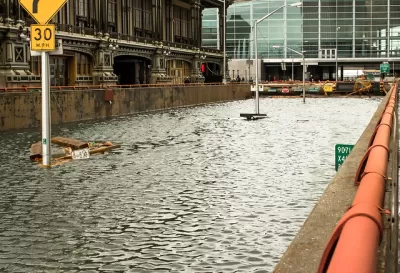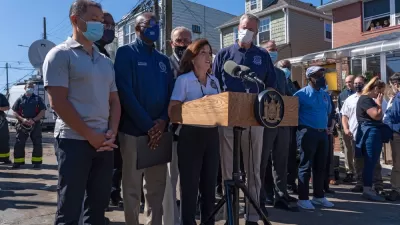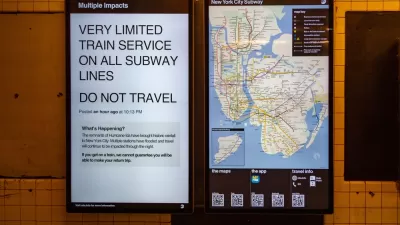The city must take urgent action to mitigate the effects of increasingly damaging rainstorms.

The flooding caused by Hurricane Ida and other storms signals a new normal for the Northeast, writes Henry Grabar, and cities like New York must prepare for more destructive rainstorms. "Climate change is making more intense rainstorms more frequent, particularly in the Northeast, and the expectations that such a storm would occur once a millennium are now obsolete." Earlier this year, "New York released its first-ever analysis of how to prepare for stormwater flooding," including goals such as to "[i]nform the public about flood vulnerability from extreme rain" and "continue developing a citywide hydrologic and hydraulic (H&H) model to better estimate runoff flow for various climate scenarios to be included in the drainage planning process."
But to date, the city has not taken much action to mitigate the potential effects of floods. Grabar outlines some solutions that could be implemented immediately "to mitigate the effects of extreme rainfall" and reduce the deaths and destruction caused by storms. The suggestions include planting more trees; improving drainage with bigger pipes and trash receptacles to keep drainage pipes clear; elevating vulnerable subway entrances and grates to protect them from stormwater; legalizing basement apartments to improve standards and safety for residents; and, perhaps most importantly, doing all of these things quickly, before another catastrophic storm has a chance to cause more damage. "The next rainstorm isn’t going to wait for the community board, and it’s certainly not waiting 1,000 years."
FULL STORY: What New York City Can Do Right Now to Prepare for the Next Biblical Rainstorm

Planetizen Federal Action Tracker
A weekly monitor of how Trump’s orders and actions are impacting planners and planning in America.

USGS Water Science Centers Targeted for Closure
If their work is suspended, states could lose a valuable resource for monitoring, understanding, and managing water resources.

Congress Moves to End Reconnecting Communities and Related Grants
The House Transportation and Infrastructure Committee moved to rescind funding for the Neighborhood Equity and Access program, which funds highway removals, freeway caps, transit projects, pedestrian infrastructure, and more.

How Complete Streets Stands to Lose in the FY26 ‘Skinny Budget’
The President’s proposed budget could cut key resources for active transportation, public transit, and road safety programs.

Dairy Queen and Rural Third Places
Dozens of Dairy Queen restaurants across Texas are closing, taking a critical community space with them.

Pittsburgh Excels at Low-Cost, Quick-Build Traffic Calming
The city’s traffic calming initiative has led to a 6 percent average reduction in speeds on corridors with recent interventions.
Urban Design for Planners 1: Software Tools
This six-course series explores essential urban design concepts using open source software and equips planners with the tools they need to participate fully in the urban design process.
Planning for Universal Design
Learn the tools for implementing Universal Design in planning regulations.
City of Moorpark
City of Tustin
Tyler Technologies
City of Astoria
Transportation Research & Education Center (TREC) at Portland State University
Chaddick Institute at DePaul University
Regional Transportation Commission of Southern Nevada
Toledo-Lucas County Plan Commissions





























